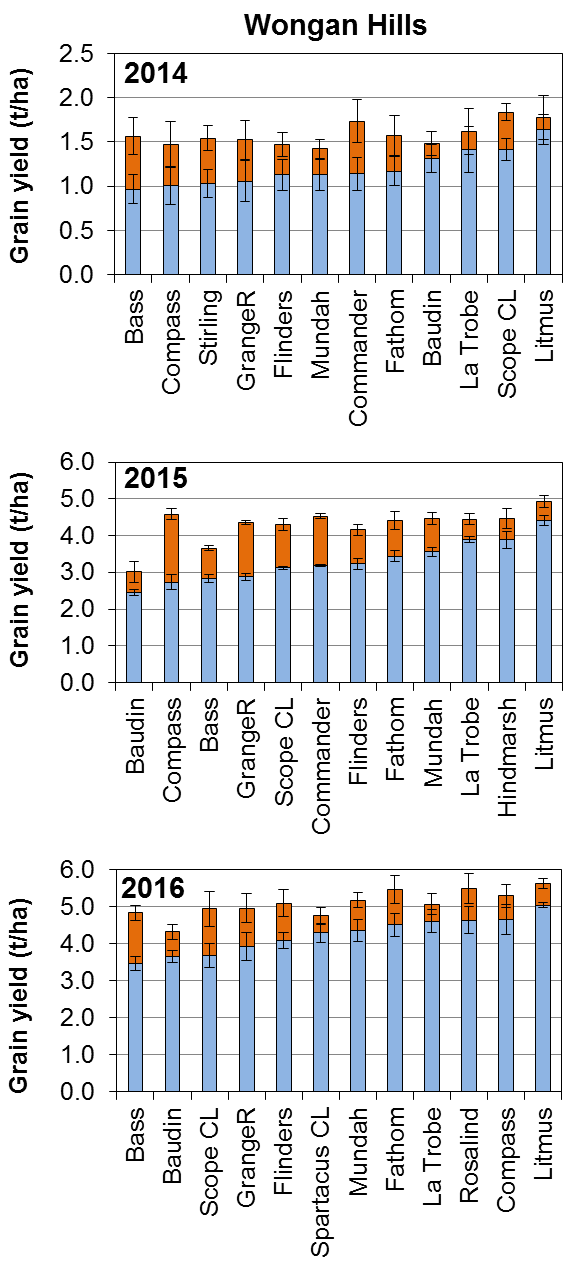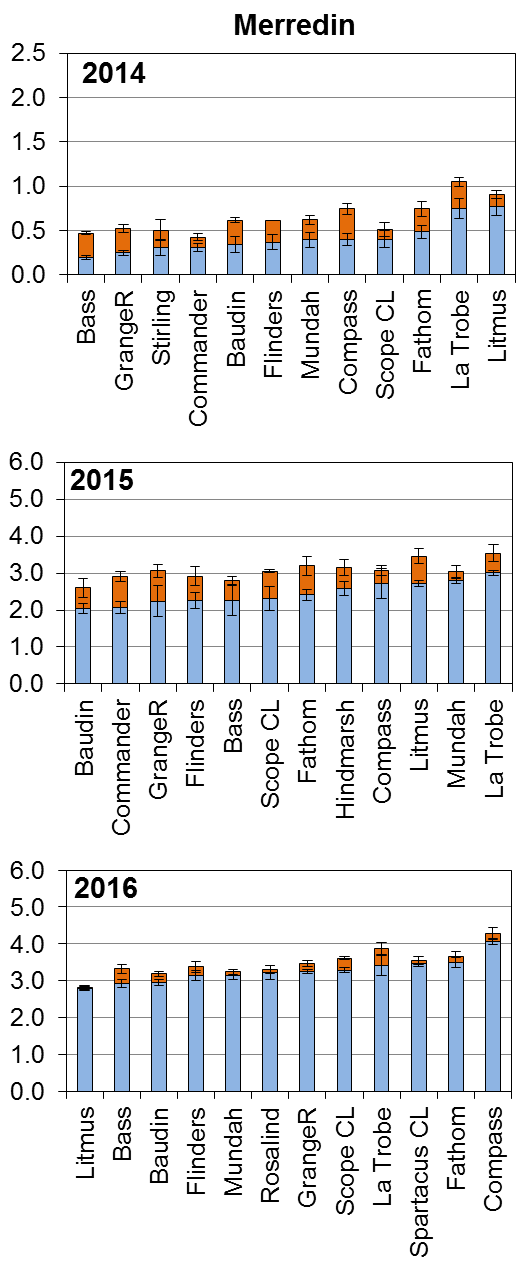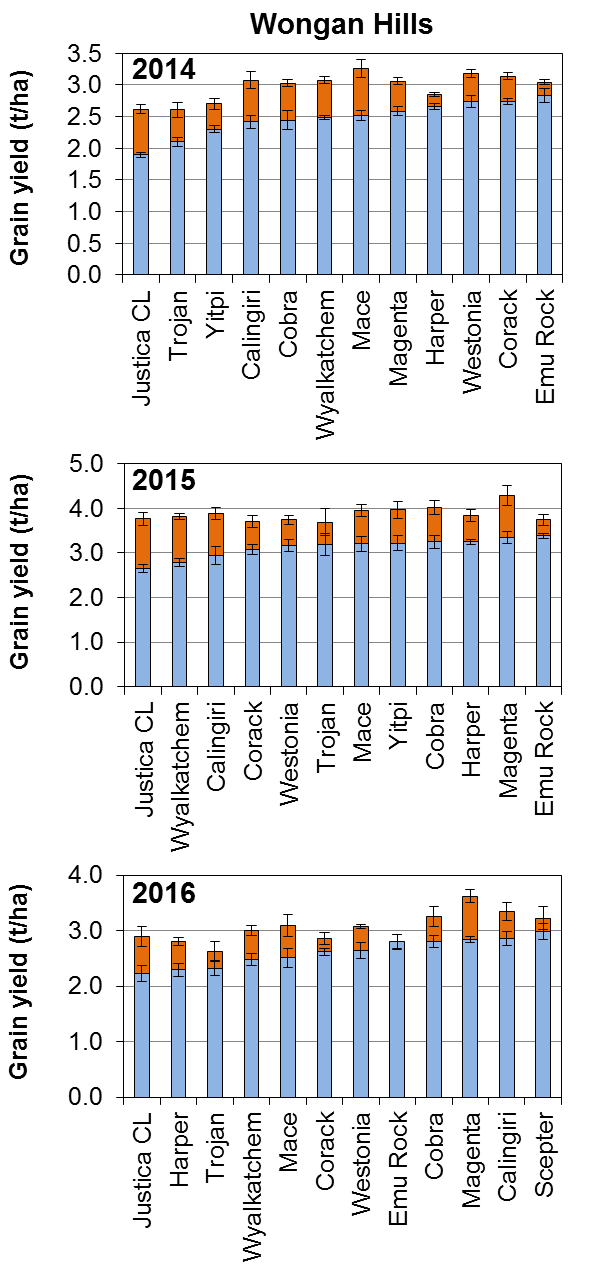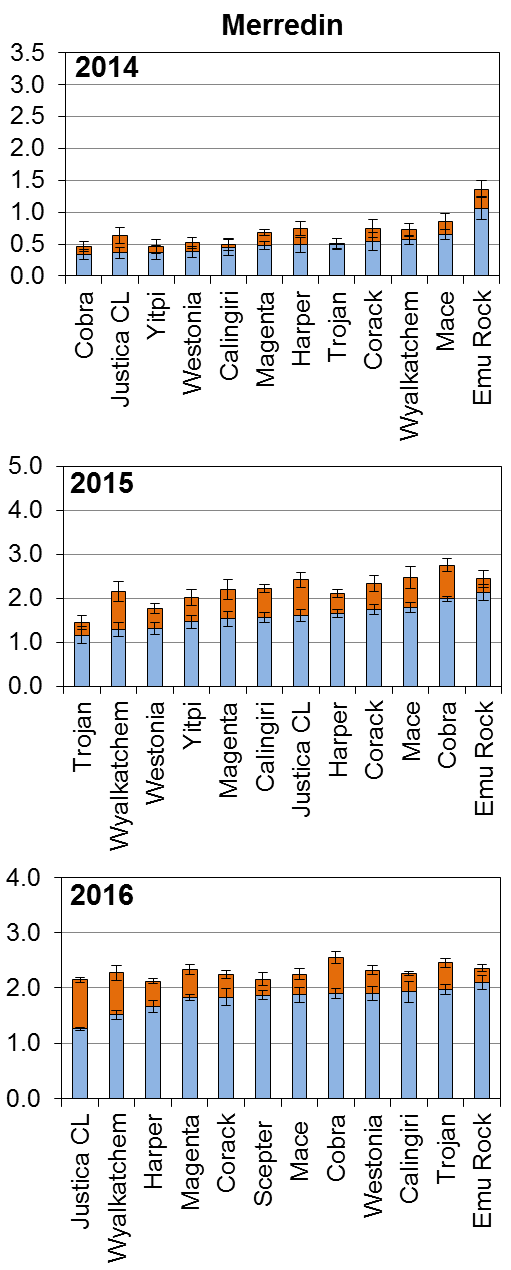Choosing the best yielding wheat and barley variety under high crown rot
Author: Daniel Hüberli, K. Gajda, M. Connor, A. Van Burgel, DAFWA | Date: 28 Feb 2017
Key messages
- Yield loss from crown rot infection varied among barley and wheat varieties in all three years tested, ranging from 0 to 1.85 t/ha (0-59% yield loss) for barley and 0 to 1.11 t/ha (0-42% yield loss) for wheat.
- An understanding of the crown rot disease history of a paddock and choosing varieties with the appropriate disease resistance ranking can improve crop yield substantially in the presence of crown rot.
Background and aims
Fusarium crown rot, caused predominantly by the stubble-borne fungus F. pseudograminearum, is one of the major root and crown disease constraints on cereal production in Australia. In 2009, it was estimated to cost Australian grain growers $97 million annually in wheat and barley (Murray and Brennan, 2009, 2010). WA’s losses to this disease were estimated at that time to be $7 million annually. In 2014, many growing regions in WA were impacted by crown rot, exacerbated by dry weather conditions during grain fill. For example, reports by agronomists and growers from Merredin indicated that crown rot affected 30-50% of wheat paddocks (Hüberli, 2014).
There is a need to evaluate wheat and barley varieties to demonstrate to growers the economic benefits of varietal selection in paddocks with high crown rot pressure. Particularly as several new wheat varieties have been released recently which appear to have improved tolerance to crown rot. This paper reports on a three year series (2014-2016) of Western region based trials to provide WA grain growers experimental field evidence of the effect of crown rot on barley and wheat variety yields in local environmental conditions.
Method
Barley and wheat varieties were sown at a targeted rate of 150 plants/m2 in separate wheat and barley trials at Merredin and Wongan Hills Research Stations in each season (2014, 2015, and 2016); refer to Table 1 for sowing dates. Sites were selected with no or low level of crown rot inoculum in the soil by taking pogo samples and sending these for PreDicta B DNA analysis at SARDI. Each trial had 12 barley and wheat varieties selected as the most commonly grown or new releases regionally relevant to WA grain growers (see Figure 1 and 2). Varieties were repeated at both locations in paired plots (10 m x 1.8 m), plus/minus F. pseudograminearum inoculum (2 g colonised wheat/m row), with four replications. All varieties were repeated across all three years except for Commander, Hindmarsh, Spartacus CL, Stirling, and Rosalind in barley trials, and Scepter and Yipti in wheat trials. NVT resistance rankings for Emu Rock and Trojan are moderately susceptible (MS), Magenta is MS to susceptible (MSS), and all remaining varieties are susceptible (S) to crown rot. For barley, Commander, Compass, Hindmarsh and Litmus were S, with the remaining varieties being S to very S (SVS). Rankings for Spartacus and Rosalind are provisional and no resistance data is available for Baudin, Mundah and Stirling.
Table 1. Sowing date and growing season rainfall for barley and wheat trials at Merredin and Wongan Hills Research Stations in 2014 to 2016.
|
Site |
Year |
Sowing Date |
Growing season rainfall (mm)A |
|---|---|---|---|
|
Merredin |
2014 |
4 June |
213 |
|
2015 |
26 May |
211 |
|
|
2016 |
24, 25 MayB |
210 |
|
|
Wongan Hills |
2014 |
28 May |
276 |
|
2015 |
21 May |
315 |
|
|
2016 |
1 June |
305 |
A Growing season rainfall - May to October
B Date for wheat and barley trial
Grain yield (t/ha) and level of disease as the number of whiteheads and basal browning, and crown rot incidence by stubble plating were measured. The growing season rainfall at each site is outlined in Table 1.
Results
No crown rot DNA was detected in the soil prior to sowing all experiments with the exception of Merredin in 2014, where a high level of background inoculum resulted in high infection in uninoculated plots, but there were still statistical differences between uninoculated and inoculated plots.
All barley and wheat varieties had reduced yield in inoculated plots with the exception of Emu Rock in 2016 at Wongan Hills that had no yield loss (Figure 1 and 2). Significant differences (P < 0.05) were evident between varieties in all years and sites tested.
In the barley trials, La Trobe and Litmus consistently had the lowest yield reductions from crown rot infection at less than 16% across most seasons and sites. Spartacus CL was only tested in 2016, and had a low level of yield loss to crown rot. Litmus and La Trobe had consistently higher yields than most other barley varieties in the presence of crown rot (Figure 1). Yield of Bass and GrangeR were consistently the most heavily impacted by crown rot infection losing up to 59% yield to the disease.


Figure 1. Mean grain yield (± standard error) for 12 barley varieties in the presence of crown rot (blue bars) and yield improvement without crown rot (orange bars) inoculum in six replicated field trials at Wongan Hills and Merredin during 2014 to 2016. Yield in the presence of crown rot is ranked from lowest to highest for each trial. In 2014, the Merredin trial had a high level of background crown rot.
In wheat, the yield of Emu Rock was the least affected by crown rot across most seasons and sites ranging between 0 to 13% yield loss to crown rot infection (Figure 2), excluding Merredin 2014. Justica CL was the lowest yielding variety under crown rot infection with the highest yield losses of 23 to 42% across all seasons and sites (Figure 2). Other varieties with a high level of yield loss were Magenta, Wyalkatchem and Calingiri, losing 15 to 40% to the disease.


Figure 2. Mean grain yield (± standard error) for 12 wheat varieties in the presence of crown rot (blue bars) and yield improvement without crown rot (orange bars) inoculum in six replicated field trials at Wongan Hills and Merredin during 2014 to 2016. Yield in the presence of crown rot is ranked from lowest to highest for each trial. In 2014, the Merredin trial had a high level of background crown rot.
Conclusion
All varieties of barley or wheat were found to be impacted by crown rot infection and all had some level of yield reduction, with the exception of Emu Rock in 2016. Significant differences between varieties in grain yield were evident in all seasons. For wheat, Emu Rock has had the lowest actual yield loss in all years and has been the highest yielding variety in the presence of disease, with the exception of 2016 at Wongan Hills where Scepter had the highest yield. Justica CL had the greatest percentage reduction in yield across all seasons and sites, with the exception of Merredin 2015, where Wyalkatchem had the greatest. For barley, Litmus and La Trobe have been the best yield performers in most instances under crown rot infection. Bass had the largest percentage yield loss to crown rot infection in 2014 and 2016 at both sites.
These results show that variety choice under high crown rot disease pressure can have an impact on yield. For example, at Wongan Hills in 2016, with added crown rot inoculum, Emu Rock yielded 0.29 t/ha (P < 0.001) more than Mace. However, in the plots without crown rot, Mace out-yielded Emu Rock by 0.30 t/ha (P < 0.001).
Understanding the crown rot disease history of a paddock and choosing varieties with appropriate disease resistance ranking can improve crop yield substantially. It is important to realise that in a year with good rainfall with no or very low levels of disease expression, inoculum levels can build-up substantially in paddocks with a tight cereal rotation and impact on future crops.
References
Murray GM, Brennan JP (2009). Estimating disease losses to the Australian wheat industry. Australasian Plant Pathology 38: 558-570.
Murray GM, Brennan JP (2010). Estimating disease losses to the Australian barley industry. Australasian Plant Pathology 39: 85-96.
Hüberli D (2014). Fusarium crown rot. PestFax, Issue 22, 10 October.
More information
Crown rot in winter cereals, Western region. GRDC Tips and Tactics
Acknowledgments
Trial sowing, management and harvest provided by Merredin and Wongan Hills Research Station staff. The research undertaken as part of this project is made possible by the significant contributions of growers through both trial cooperation and the support of the GRDC, the author would like to thank them for their continued support.
Paper reviewed by: Steven Simpfendorfer (NSW DPI), Sarah Collins (DAFWA)
Varieties displaying this symbol beside them are protected under the Plant Breeders Rights Act 1994.
GRDC Project Code: DAN00175,
Was this page helpful?
YOUR FEEDBACK
